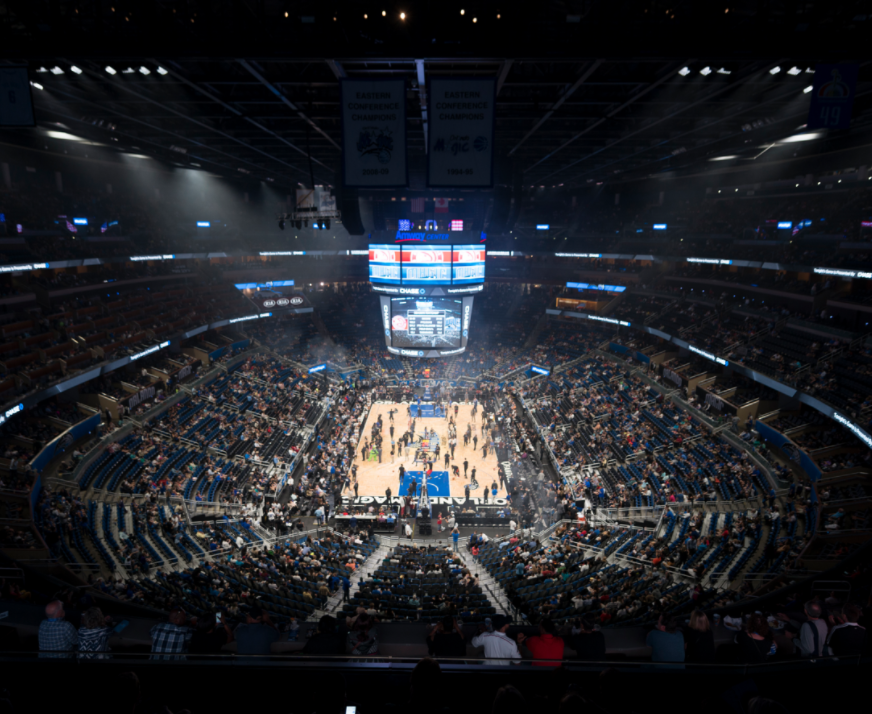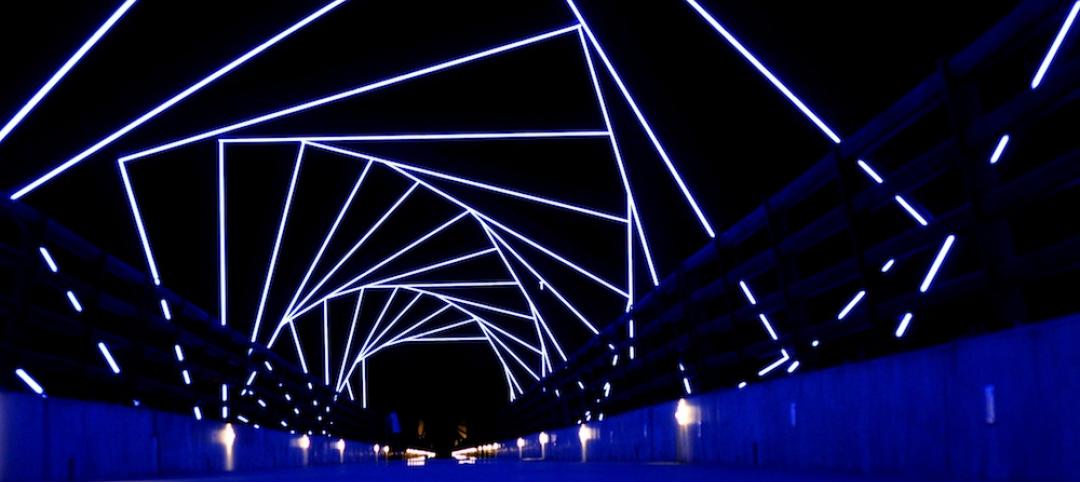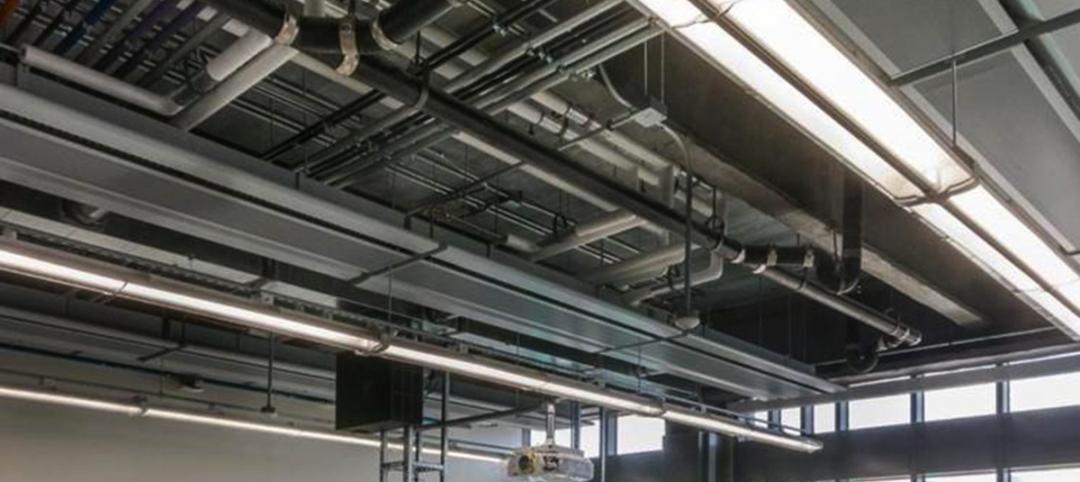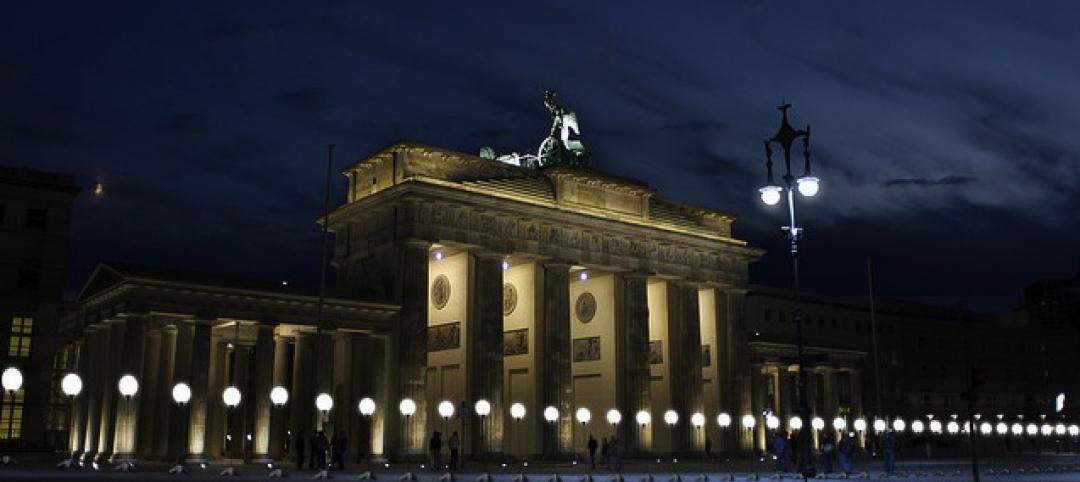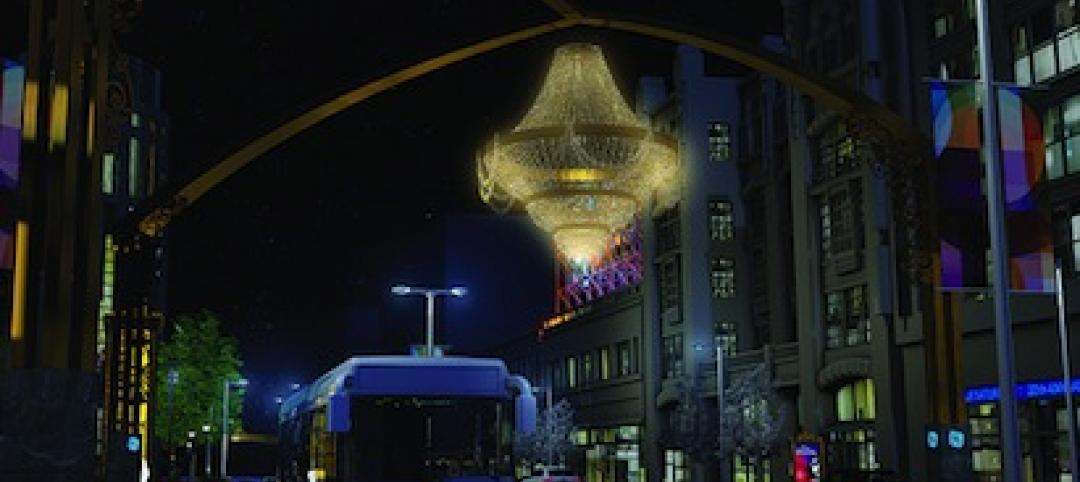Orlando’s Amway Center was the first NBA team facility to achieve LEED certification, earning LEED NC 2.2 Gold in 2011. Since then the performance of LED lighting technology has significantly improved, as well as becoming more affordable. In 2007 Orlando City Mayor Buddy Dyer launched Green Works Orlando with the goal of making the city one of the most environmentally-friendly, economically and socially vibrant communities in the nation.
A key step has been a continued decrease in energy and water use at city-owned buildings, including the Amway Center. Unlike many major venues, Amway Center is owned and operated by the City of Orlando. TLC Engineering for Architecture, Inc. has completed energy audits and upgrades to continue to assist the City achieve its Green Works goals, with significant savings potential at the Amway Center due primarily to the very heavy use of the facility.
Tackling energy and water use for an 875,000 square-foot building that hosts more than 200 events annually required close coordination with numerous stakeholders, approvals from the sports’ governing bodies and detailed evaluation of potential contractors. The initial Amway Center retro-fitting effort focused on the lighting in the arena bowl and practice court. Phase 2 concentrated on the remaining lighting and the efforts resulted in significant savings.
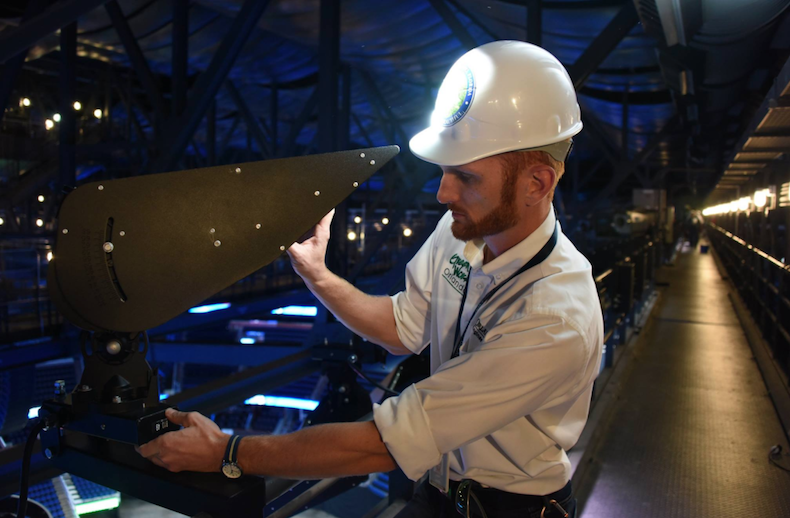 Ian LaHiff, PE, LEED AP BD+C, Energy Project Manager, City of Orlando with the newly installed LED fixtures, in the maintenance position. Photo: city of Orlando
Ian LaHiff, PE, LEED AP BD+C, Energy Project Manager, City of Orlando with the newly installed LED fixtures, in the maintenance position. Photo: city of Orlando
1. Know who is there and how they’re using the variety of lighting.
Amway Center events include the NBA Basketball’s Orlando Magic, NCAA basketball (such as March Madness), ECHL ice hockey, ice shows, world-class concerts, professional wrestling and local community and faith-based events, each with their own unique lighting levels and duration. The engineering team developed an extensive matrix of “functional programs” detailing how and when specific lighting fixtures (aisle, work, house, sports and catwalk) were used for each of the events.
Equally important during the data gathering phase was factoring in the many times the facility was cleaned overnight to facilitate back-to-back events. If the lights were on, the team needed to know the details of use. “Trust but verify” became the team’s mantra.
2. Plan the work, work the plan.
The tightly documented schedule revealed the exact lighting required in all cases and became the foundation for the City’s detailed, performance-based Request for Proposal. Instead of taking the City’s typical route of issuing an IFB and focusing solely on installation first cost, the RFP specified most variables that bidders could interpret differently and required that bidders clearly identify how they would meet the required lumen levels, glare, multi-sport performance specifications and more.
The RFP offered a performance scoring mechanism that provided points for innovation, creativity and highly experienced personnel. A numerical equation was developed that considered the first cost, operating and maintenance savings, and payback period on a weighted basis. This helped contractors balance their offerings, and self-score their alternatives to maximize their responses.
Requiring spreadsheet responses allowed decision makers to make apples-to-apples comparisons. Key stakeholders had a voice in the final selection, recognizing the importance of their opinions in the overall success of the program. The RFP included a clause that any additional lights necessary to meet performance specifications added subsequent to the bid and selection would be at the contractor’s expense, for both installation and future energy costs, assuring that submittals were fully disclosive.
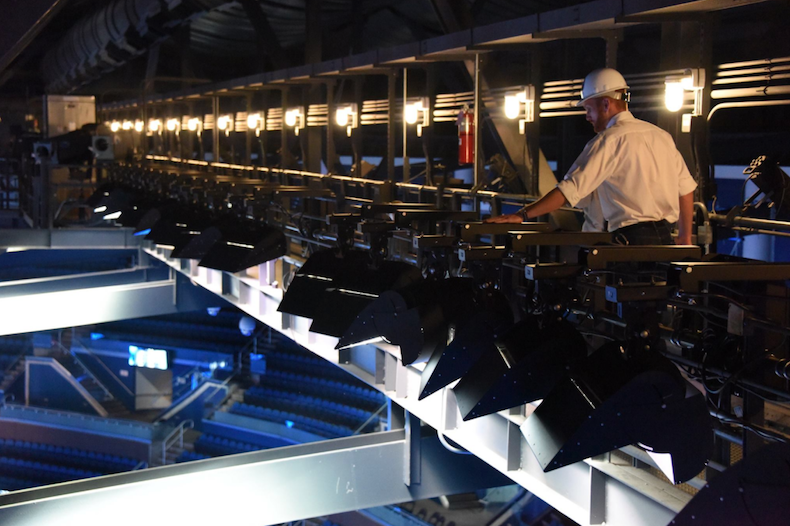 Installed LED fixtures on the catwalk high above the main floor of Amway Center. The catwalk became much less congested as the total number of light fixtures was reduced since the LED fixtures can multi-task. Photo: city of Orlando
Installed LED fixtures on the catwalk high above the main floor of Amway Center. The catwalk became much less congested as the total number of light fixtures was reduced since the LED fixtures can multi-task. Photo: city of Orlando
3. Practice like you play.
Professional sports equal big money. And the potential risk of relighting the Amway could have had negative, expensive impact. With just a 10-day window for Musco Sports Lighting, the selected contractor, to complete the majority of the work, the pressure was on. With a pressing line up of events following close on the October 2016 installation, nerves were taut.
Results were dramatic as LED installation progressed and former skeptics became advocates. The Orlando Magic, the major tenant, was 100% satisfied when they saw how the LED lighting significantly improved illumination of their practice court, allowing the players to train and condition under the same technology as the main arena bowl. The LED practice court lights also allow for more intimate lighting levels, creating a whole new atmosphere for VIP banquets held on the practice court.
At the project inception, the NBA LED lighting specification was in development but caught up to the Amway project and was incorporated in the bid documents. After installation, the NBA sent a third party to review the completed bowl lighting prior the first game.
The season started as planned—with very satisfied stakeholders and excited fans. The ECHL has also approved all the lighting changes, supporting continued play by the Orlando Solar Bears who are affiliated with the Toronto Maple Leafs. While the intent for the main bowl was to maintain all existing scenes, the Magic production team enjoys the new experiential lighting effects that add excitement to the game for players and fans, with chasing lights circling the arena and strobing celebrating big plays.
4. Savings on more than the light bill.
Many Amway Center events are broadcast which meant a two-year cycle for replacing every single bulb, recognizing the barely perceptible, but real degradation that occurs over time. Thus the maintenance budget for systematically replacing bulbs was significant.
With LEDs in place, less degradation takes place and the service life is significantly longer. Technology allows for slight overdriving of the LED as it ages, resulting in a more consistent performance over a much longer period of time. Additionally, all metal halide lights and shutters have been eliminated, reducing maintenance.
Equally important was the number of light fixtures removed during the re-design. Instead of lights for specific events, the LED fixtures can be controlled more precisely, reducing the number of overall fixtures.
5. The future is bright.
Going forward, the DMX system was updated with the latest controls language to integrate with future controls. The reduced lighting load makes the building more resilient. Should a power disruption occur, LEDs return much more quickly and the potential exists to power all the bowl lighting from backup power with the same generator that previously powered only primary systems due to reduced demand.
A similar RFP was issued for Phase 2, which updates much of the rest of the building to LED fixtures, with the goal of being minimally noticeable due to the non-specialty nature of the fixtures. LEDs have been determined appropriate for all but a few VIP restaurants and bars that require low lighting levels.
The selected lighting retrofit option for the bowl and practice court is estimated to save $89,000 annually in energy and maintenance costs. The selected Phase 2 retrofit option is estimated to save $230,000 annually.
The combined simple payback of the measures is approximately 5.9 years. The Amway Center is shining brightly, inside and out, while saving money for the City and providing great fan experiences.
About the Authors: Ian LaHiff, PE, LEED AP BD+C, is a Energy Project Manager with the city of Orlando. Wayne Allred, PE, CxA, LEED AP BD+C, is Principal and Orlando Operations Director with TLC Engineering for Architecture
Related Stories
Lighting | Sep 11, 2015
Lighting and climate zone changes proposed for ASHRAE/IES energy standard
Twenty-three items open for public review through Oct. 4
Green | Jul 7, 2015
Philips sheds new light on growing fresh food indoors
A research center in The Netherlands is testing the latest techniques in urban farming.
Lighting | Jun 17, 2015
LED lighting: Replaceable or disposable?
While first generation LED lighting fixtures were basically your standard incandescent or fluorescent housing retrofitted with LED light boards, manufacturers have now begun designing fixtures around the LEDs, writes SmithGroupJJR's Michael Nowicki.
High-rise Construction | Apr 6, 2015
Melbourne tower will light up depending on weather
The tower will be illuminated by 164-foot-tall beams of LED light based on weather updates from the Bureau of Meteorology.
| Oct 16, 2014
Germany to commemorate Berlin Wall anniversary with 10-mile LED 'balloon' installation
The project, named Lichtgrenze (or Border of Light), makes for a colossal art installation dividing Berlin back to East and West. Eight thousand LED light-filled balloons, each 11 feet high, will line the path.
| Jul 25, 2014
Grocery stores choosing Green Globes for building sustainability certification
The Green Building Initiative (GBI) has announced a wave of Green Globes certifications for new grocery stores, including New Seasons Markets, Whole Foods, Price Chopper, Aldi’s, Harris Teeter, Wegmans, and Publix.
| Jun 23, 2014
Lilker Associates launches Lighting Group; David Cyr announced as Director
New division rounds out building systems services offerings for the Manhattan-based consulting firm.
| May 22, 2014
Facebook, Telus push the limits of energy efficiency with new data centers
Building Teams are employing a range of creative solutions—from evaporative cooling to novel hot/cold-aisle configurations to heat recovery schemes—in an effort to slash energy and water demand.
| May 2, 2014
World's largest outdoor chandelier tops reworked streetscape for Cleveland's PlayhouseSquare
Streetscape project includes monumental gateway portals, LED signage, and a new plaza, fire pit, sidewalk café, and alfresco dining area.


